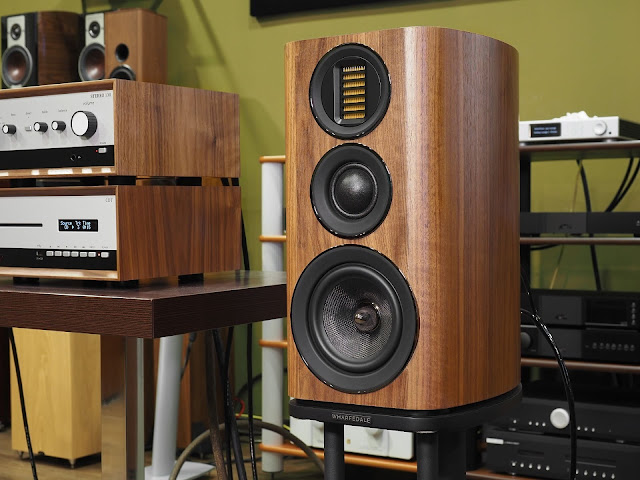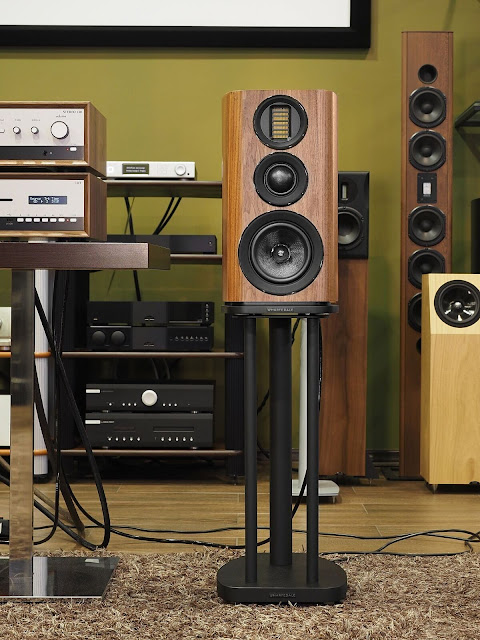Wharfedale EVO 4.2 bookshelf Test
light, comfortable and a bit snobbish
The Wharfedale company updated the EVO line back in 2019, and we have already tested the older floorstanders with an index of 4.4 . Large shelf speakers EVO 4.2 also turned out to be quite popular - and for good reason: these are full-fledged three-way speakers, which are inferior to floor speakers only in assertiveness in the bass range, but at the same time they cost noticeably less.
And now branded racks have also appeared for them - the same shape that perfectly repeats the curves of the sidewalls of the cases, massive and strong. A great reason to remember the EVO 4.2 themselves.
It's all about color
I've been familiar with these speakers for a long time: a pair of radiant white bookshelves helped me in a big experiment where we tried to find out how height affects the perception of music. This time, EVO 4.2 in walnut veneer was with me in the showroom - matte, warm, cozy. The white version looks more high-tech: the combination of body color, woven Kevlar, golden ribbon tweeter looks very technological and modern. But the walnut version is simply a direct successor to the EVO line, along with all the curves, proportions and colors.
The case is uneven: in horizontal section it looks like a truncated parabola, tapering towards the rear wall. This form is dictated not by aesthetics, but by physics: it's all about the fight against standing waves, reflections and other undesirable options for the distribution of air inside the case. The front and back panels smoothly merge into rounded sides, while the top panel, on the contrary, has clear, even ribs. The veneer fits perfectly - no chips, no extra seams, no unevenness.
Behind - two pairs of terminals connected by jumpers. If desired, biwiring or biamping can be organized. The terminals are located slightly at an angle, due to which it is quite convenient to connect cables.
The most interesting, however, is located at the very bottom of the acoustics - this is a branded phase inverter, the bell of which is directed to a thick base, about a centimeter away from the main body. Such a system called SLPP was developed for the top Elysian line and transferred to the EVO. Its main advantage is the simplification of the arrangement of acoustics. Yes, the loudspeakers are still louder near the wall, but at the same time, with the addition of the bottoms, they do not lose their clarity, which happens in models with a phase inverter on the rear panel, which begin to mumble dully.
The EVO lines and the top-end Elysian were developed in parallel, and borrowings were not limited to the phase inverter. The series also have Kevlar woofers in common, however, they still have differences. The most noticeable visually are the phase-equalizing bullets, which shine with gloss in the EVO, and dense, long-travel rubber suspensions. And in fact, EVO has a midwoofer: it plays right up to 1.3 kHz.
At the very top is a ribbon tweeter - and this is a simplified version of what is in the Elysian. It has different dimensions, a different membrane material, a different shape of the antiresonant ring - but the sound is clear, fast and clear, capable of sounding realistic in a wide frequency range and devoid of excessive tape analyticity. The tweeter plays from 3.9 to 22 kHz.
The mid-range is handled by a dome driver designed specifically to work in tandem with this tweeter. They tried to make it as fast as possible, supplemented it with an acoustic chamber of a special shape, and as a result, they achieved a linear frequency response in the operating frequency range. The dome itself is slightly recessed into a small horn, due to which it plays widely.
It turned out to be honest three lanes for three speakers - and the signal across them is scattered by a crossover with polypropylene capacitors and coils with air and silicon-iron cores, carefully calculated and brought to mind after long hours of test listening. The developers set out to create the most complete sound, soften the boundaries at which the speakers are joined to each other.
Neutral territory
With a pair of Leak devices - the Stereo 130 amplifier and the CDT transport - the veneered EVO 4.2s are perfectly combined. The old-school components and the retro-futuristic roundness of the acoustics themselves are like two different "hello" from the same era. But this is not the only system with which I listened to EVO 4.2. And with different components, the character of acoustics was fully felt.
With branded racks, the acoustics are quite high - with a rack height of 60 cm, the tweeter is even slightly higher than the ears, if you fall apart on a soft sofa. But it is at this level that the dome midrange is located - and it tries its best.
The voices are a little ennobled, as if additional volume has been added to them, enhancing the effect of presence. Type O Negative, Depeche Mode, Pet Shop Boys - such male vocals with a touch of melancholy, surrounded by electronic samples, both iridescent and aggressive, sound perfectly performed by EVO 4.2. There is something intelligent-neutral, accurate, prone to professionalism in their sound.
A huge plus of the Wharfedale ribbon tweeter, which I noticed both in the EVO series and in the Elysian, is that it does not have excessive ribbon sharpness, no dryness, coldness and analyticity, no harshness. It is accurate, but at the same time neutral and quite realistic. He does not try to screw into his ears the most sonorous samples, the most creaky roar, the brightest details - these moments do not come to the fore, but organically fit into the overall outline of the melody.
A single rubber-suspended woofer is fast and crisp with the right amplification. With the same Leak, he played softly, gently, but with other partners he could well hammer juicy that Infected Mushroom, that perky American rocker, without rolling into the mud. At the same time, the massiveness in the bass was enough for most genres, except for the most extreme ones. The soft waves in the rhythm section of the trip-hop rolled quite noticeably, but for the djent the tangibility was lacking.
This is where the difference from the EVO 4.4 floorstanders lies: they win back the bottoms much more actively, although also without much enthusiasm. But they obviously have more meat than in large, but still shelf racks. Otherwise, the sound is similar to that of older floor speakers, that of older shelf speakers.
It seems to be very solid - there is no feeling that any particular speaker plays specific frequencies, the melody flows evenly, in a balanced way. Oddly enough, this effect was most noticeable on the tracks Orbital, Morcheeba and Massive Attack - they were perceived as whole stories, not just sets of sounds.
Parallel placement allows EVO 4.2 to play wide, deep, on a large scale, the music almost breaks away from the speakers and fills the entire space, but the images lose their boundaries a little. The saxophone begins to play "somewhere to the right", the stereo effects wandering from channel to channel are smeared over the area. Those who are fond of music with a flanger should better turn the acoustics on themselves.
But even with a parallel arrangement, saxophones, trumpets and trombones in the tracks of 1/2 Orchestra were, although blurry, but still separate spots, did not get confused with each other, did not mix mindlessly.
And it seems that these acoustics are primarily created for something melodic. Yes, you can even play Dragonforce with current amplifiers, even Haggard - EVO 4.2 will reproduce this music clearly and accurately, but they will not have enough punch, which is necessary in such genres of forceful aggression.
But something fluid, iridescent, deliberately beautiful - it is this kind of music that reveals this acoustics, gives it the opportunity to play a large, wide stage, fill everything around with a sound that balances between naturalness, neutrality and detachment.
Everything in the world is beauty
These columns are intellectuals. In a world ruled by bright acoustics with high frequencies raised, EVO 4.2 seem even soft - but in fact they try to be calm, even, neutral. And this plays into their hands in some genres, but spoils relations with others.
They do not like maximalism, so extreme genres with the distortion knob turned to the maximum play boringly clean - even with powerful amplification. Drum and bass and some psy-trance tracks go to the same steppe. Taking examples from Infected Mushroom, "Heavyweight" and "Dancing with Kaddafi" fit perfectly into the EVO 4.2's character, and nimble things need more meat. And one more speaker can't fix it: even the floor-standing EVO 4.4. keep this approach to music.
This acoustics is about beautiful sound. About him, one might say, aesthetics without too much analyticity. By amplification, you can improve the character by adding drive or softness - but in general, this balanced, lively, but not oversaturated with emotions presentation will remain.
Pros
Neutral and natural presentation, large stage, fast bass, unobtrusive tape, interesting design
Cons
For some genres, the acoustics seem to be not emotional enough, there is not enough punch on the bottoms
OFFICIAL SITE
Specs Wharfedale EVO 4.2
Type: shelf, three-way
Acoustic design: SLPP bass reflex
Frequency response: 48 - 22,000 Hz (+/- 6 dB)
Maximum sound pressure: 105 dB
Crossover frequency: 1400 Hz, 3900 Hz
Speakers: HF - ribbon 30 x 60 mm, MF - 50 mm fabric dome with damping coating, woofer - 165 mm with a Kevlar cone on a rubber suspension
Sensitivity: 87 dB
Resistance: 8 ohms nominal, 4 ohms minimum
Dimensions (HxWxD): 455 x 250 x 350 m
Weight: 13.4 kg (each)

















.jpg)



0 Comments